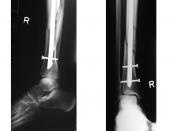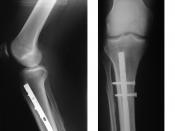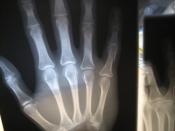Name and explanation of the injury
The lower leg has two bones that connect the knee to the ankle: the tibia and the Fibula. The tibia is the larger of the two bones and runs on the inside of the lower leg, it is the weight bearing bone. The Fibula is much smaller and runs along the outside of the lower leg (shin fracture).
"Of all the body's long bones, the tibia is not only the most likely to be fractured, but it is also the most likely to break through the skin when it fractures. This greatly increases the risk of bacterial contamination and infection at the fracture site. It also may prevent normal healing. The sharp ends of a broken tibia can cut into nearby nerves and blood vessels, and cause serious damage to soft tissues inside the lower leg.
In 75 percent to 85 percent of patients with tibia fractures, the fibula is fractured as well.
Doctors treat more than 185,000 lower leg fractures in the United States every year, including both tibia fractures and fibula fractures" (leg fracture).
There are a variety of different types of fractures:
* Complete: the broken bone is completely broken.
* Incomplete: the broken bone is not completely broken.
* Comminuted: there are more than 2 bone fragments at the fracture.
* Compound (open): one end of the broken bone has broken through the skin.
* Closed: neither end of the broken bone has pierced the skin.
* Compression: the bone has broken due to extreme pressure.
* Impacted: the ends of the broken bone are driven into each other.
* Avulsion: the muscle has pulled a portion of the bone away from where it was originally attached.
* Stress: a partial fracture, which is a hairline crack in a bone...


